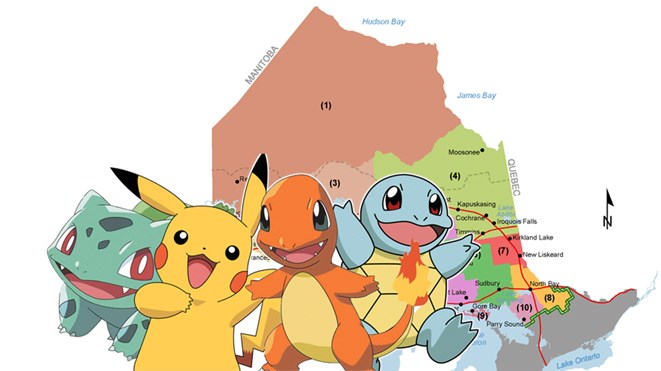By Mike Commito
Editor’s note: Just in case you miss the joke, there is no version of the game that reflects the geographical challenges of life in Northern Ontario. The writer is simply using the game as a tongue-in-cheek springboard to explore the topic. Hopefully, he didn’t get your hopes up.
Unless you’ve been living under a rock, chances are you’ve heard the buzz around the new mobile game Pokémon Go.
The Nintendo classic from 20 years ago has been resurrected and has certainly made itself at home in the 21st century. It has already been downloaded 7.5 million times and is grossing $1.6 million per day, and that’s just in the United States. The game has yet to be officially released in Canada, but that hasn’t stopped users north of the 49th parallel from wading into the augmented reality universe.
For those unfamiliar, the original game tasked users with catching and training pocket monsters, a.k.a. Pokémon. Your job as a trainer was to catch all 151 creatures hidden throughout the Pokémon world and evolve them into more powerful monsters by training and battling them. The latest edition takes this premise to the next level by using the GPS and clock in your smartphone to allow you to search for virtual Pokémon in the real world.
While anticipation continues to bubble up in Canada, prospective gamers in Northern Ontario have additional reason to get excited. There’s a rumour floating around that Nintendo has designed a special version of Pokémon Go that reflects the realities of life in the region. Sudbury.com was fortunate enough to receive an advance copy in order to ensure its gameplay accuracy and we can with certainty that Nintendo did its homework.
Unfortunately for Northern Ontarians, much like our own population, there are very few Pokémon hiding out in our region. According to the 2011 census, there are nearly 13 million people who live in the province, with only 6 per cent living in the North.
If we assume that there are 151 Pokémon (the maximum number in the game) for every resident of Ontario, that would mean there would be roughly 1.8 billion Pokémon in southern Ontario, compared to 113 million in the north.
Further complicating the situation for would-be gamers is geography.
Northern Ontario covers 802,000 square kilometers, representing nearly 90 per cent of the province’s total land mass. If we were to break down the number of Pokémon by kilometre squared, it would be far more difficult to catch one in Northern Ontario as there would only be 14,195 monsters for every square kilometer compared to the nearly 1.3 million for the same unit down south.
Even the best Pokémon trainers will be limited by the north’s geographical encumbrances.
Even if you could clear these topographical hurdles, you would still need to contend with the region’s infrastructure gaps. The biggest issue being that of Internet connectivity. While the game primarily relies on your smartphone’s GPS and clock system, you will still need data to start your quest.
According to Connected North, 70 per cent of households in the region have access to affordable broadband internet service, but this varies throughout the region.1 In fact, average access in communities with less than 2,000 residents is only 38 per cent.
The situation is worse in more remote communities where affordable high-speed internet is nearly non-existent.
Even if you are able to find a decent connection on your phone, finding a direct path to your Pokémon is easier said than done. Crumbling infrastructure, ongoing road construction, and limited public transit services options all make finding Pokémon in Northern Ontario create an additional element of frustration on your adventure.
And good luck finding a Pokéstop along the way. For the uninitiated, Pokéstops are stations in the game that distribute prizes or rewards, and are usually connected to real world places of interests, such as tourist attractions. Nintendo has linked all of Northern Ontario’s Pokéstops to highway rest areas.
The good news is that, according to a 2015 inventory from the Ontario Ministry of Transportation, the government operates 187 rest areas across the province. These range from picnic areas, parks, science lookouts, and simple pullovers.
This breaks down to 73 in the northeastern region, 44 in in the northwest, 33 in the eastern region, 30 in western Ontario, and seven in the central region. While the overwhelming majority of these are located in Northern Ontario, some have suggested that rest areas are still well out of reach of many travelers.
According to Frank O'Connor, president of the Superior Coastal Highlands Tourism Association, “There is a 160-kilometre stretch along Highway 17 that does not have any rest stations. The only washrooms that are available to drivers along the Sault Ste. Marie to Thunder Bay corridor are outhouses.” Moreover, of the 117 rest areas operated in the northeast and the northwest, only five are operated year-round. Better start rounding up those Pokémon before the snow hits.
It seems that pursuing Pokémon in the North will not be for the faint of heart, you’ll need to be prepared to deal with some significant geographic and infrastructural challenges. Until we work towards comprehensive solutions for issues related to accessibility, internet connectivity, and highway rest areas, the North will not be a Pokémon haven.
So if you want to catch ‘em all, you’ll need to be determined and resilient, much like the people of Northern Ontario.
Mike Commito is the Research Coordinator at Northern Policy Institute.
1 The Canadian Radio-Television and Telecommunications Commission defines high-speed internet as 5 mbps for downloading and 1 mbps for uploading
A rotating stable of community members share their thoughts on anything and everything, the only criteria being that it be thought-provoking. Got something on your mind to share with readers in Greater Sudbury? Climb aboard our Soapbox and have your say. Send material or pitches to soapboxsoapbox@sudbury.com.
